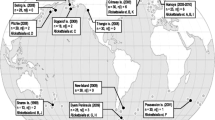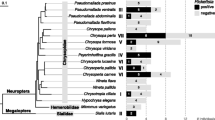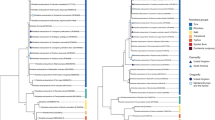Abstract
Field-collected specimens of glossiphoniid leeches, Torix tagoi, Torix tukubana, Hemiclepsis marginata, and Hemiclepsis japonica, were surveyed for Rickettsia infection by using a diagnostic PCR assay. Rickettsia was detected in 96% (69/72) of T. tagoi, 83% (24/29) of T. tukubana, 29% (33/113) of H. marginata, and 0% (0/30) of H. japonica. The frequencies of Rickettsia infection were stably maintained in different seasons. In H. marginata and T. tukubana, distant local populations exhibited remarkably different frequencies of Rickettsia infection. Eggs carried by infected females of T. tagoi and H. marginata were all Rickettsia-positive, indicating nearly 100% vertical transmission. Analysis of 16S rDNA sequences revealed that phylogenetic relationship of the leech-associated Rickettsia reflected the specific and populational divisions of the host leeches. However, circumstantial lines of evidence strongly suggested that horizontal transmission of Rickettsia must have occurred in the ancestors of these leeches. In T. tagoi and T. tukubana, infected individuals were remarkably larger in size than uninfected individuals, wheras in H. marginata, infected and uninfected individuals were almost comparable in size. This study first provides information on ecological aspects of leech-bone endocellular bacteria of the genus Rickettsia. On the basis of these data, we discuss possible mechanisms whereby Rickettsia infection is maintained in natural populations of these leeches in the freshwater ecosystem.


Similar content being viewed by others
References
JO Andersson SG Andersson (2000) ArticleTitleA century of typhus, lice and Rickettsia Res Microbiol 151 143–150 Occurrence Handle10.1016/S0923-2508(00)00116-9 Occurrence Handle10865960
JD Baxter (1996) ArticleTitleThe typhus group Clin Dermatol 14 271–278 Occurrence Handle10.1016/0738-081X(96)00011-9 Occurrence Handle8727129
DQ Chen BC Campbell AH Purcell (1996) ArticleTitleA new Rickettsia from a herbivorous insect, the pea aphid Acyrthosiphon pisum (Harris) Curr Microbiol 33 123–128 Occurrence Handle10.1007/s002849900086 Occurrence Handle8662184
GA Dasch E Weiss (1992) The genera Rickettsia, Rochalimaea, Ehrlichia, Cowdaria, and NeoRickettsia A Balows HG Truper M Dworkin W Harder K-H Schleifer (Eds) The Prokaryotes, vol 3 Springer-Verlag New York 2407–2470
MJ Davis ZT Ying BR Brunner A Pantoja FH Ferwerda (1998) ArticleTitleRickettsial relative associated with papaya bunchy top disease Curr Microbiol 36 80–84 Occurrence Handle10.1007/s002849900283 Occurrence Handle9425244
O Folmer M Black W Hoeh R Lutz R Vrijenhoek (1994) ArticleTitleDNA primers for amplification of mitochondrial cytochrome c oxidase subunit I from diverse metazoan invertebrates Mol Mar Biol Biotechnol 3 294–299 Occurrence Handle7881515
T Fukatsu (1999) ArticleTitleAcetone preservation: a practical technique for molecular analysis Mol Ecol 8 1935–1945 Occurrence Handle10.1046/j.1365-294x.1999.00795.x Occurrence Handle10620236
T Fukatsu N Nikoh (1998) ArticleTitleTwo intracellular symbiotic bacteria from the mulberry psyllid Anomoneura mori (Insecta, Homoptera) Appl Environ Microbiol 64 3599–3606 Occurrence Handle9758773
T Fukatsu M Shimada (1999) ArticleTitleMolecular characterization of Rickettsia sp. in a bruchid beetle Kytorhinus sharpianus (Coleoptera: Bruchidae) Appl Entomol Zool 34 391–397
T Fukatsu N Nikoh K Kawai R Koga (2000) ArticleTitleThe secondary endosymbiotic bacterium of the pea aphid Acyrthosiphon pism (Insecta: Homoptera) Appl Environ Microbiol 66 2748–2758 Occurrence Handle10.1128/AEM.66.7.2748-2758.2000 Occurrence Handle10877764
T Fukatsu T Tsuchida N Nikoh R Koga (2001) ArticleTitleSpiroplasma symbiont of the pea aphid, Acyrthosiphon pisum (Insecta: Homoptera) Appl Environ Microbiol 67 1284–1291 Occurrence Handle10.1128/AEM.67.3.1284-1291.2001 Occurrence Handle11229923
S Hoshizaki T Shimada (1995) ArticleTitlePCR-based detection of Wolbachia, cytoplasmic incompatibility microorganisms, infected in natural population of Laodelphax striatellus (homoptera: Delphacidae) in central Japan: has the distribution of Wolbachia spread recently? Insect Mol Biol 4 237–243 Occurrence Handle8825761
AC James JWO Ballard (2000) ArticleTitleExpression of cytoplasmic incompatibility in Drosophila simulans and its impact on infection frequencies and distribution of Wolbachia pipientis Evolution 54 1661–1672 Occurrence Handle11108593
Y Kikuchi S Sameshima O Kitade J Kojima T Fukatsu (2002) ArticleTitleNovel clade of Rickettsia spp. from leeches Appl Environ Microbiol 68 999–1004 Occurrence Handle10.1128/AEM.68.2.999-1004.2002 Occurrence Handle11823253
M Kimura (1980) ArticleTitleA simple method for estimating evolutionary rate of base substitutions through comparative studies of nucleotide sequences J Mol Evol 16 111–120 Occurrence Handle7463489
N Kondo N Ijichi M Shimada T Fukatsu (2002) ArticleTitlePrevailing triple infection with Wolbachia in Callosobruchus chinensis (Coleoptera: Bruchidae) Mol Ecol 11 167–180 Occurrence Handle10.1046/j.0962-1083.2001.01432.x Occurrence Handle11856419
ET Lawson TA Mousseau R Klaper MD Hunter JH Werren (2001) ArticleTitleRickettsia associated with male-killing in a buprestid beetle Heredity 86 497–505 Occurrence Handle10.1046/j.1365-2540.2001.00848.x Occurrence Handle11520350
JE Light ME Siddall (1999) ArticleTitlePhylogeny of the leech family Glossiphoniidae based on mitochondrial gene sequences and morphological data J Parasitol 85 815–823 Occurrence Handle10577715
SL O’Neill AA Hoffmann JH Werren (Eds) (1997) Influential Passengers: Inherited Microorganisms and Arthropod Reproduction Oxford University Press Oxford
RL Regnery CL Spruill BD Plikaytis (1991) ArticleTitleGenotypic identification of Rickettsiae and estimation of intraspecific sequence divergence for proteins of two rickettsial genes J Bacteriol 173 1576–1589 Occurrence Handle1671856
LW Roberts G Rapmund FC Cadigan SuffixJr (1977) ArticleTitleSex ratios in Rickettsia tsutsugamushi-infected and noninfected colonies of Leptotrombidium (Acari: trombiculidae) J Med Entomol 20 89–92
F Rousset HR Braig SL O’Neill (1999) ArticleTitleA stable triple Wolbachia infection in Drosophila with nearly additive incompatibility effects Heredity 82 620–627 Occurrence Handle10.1046/j.1365-2540.1999.00501.x Occurrence Handle10383683
V Roux D Raoult (1995) ArticleTitlePhylogenetic analysis of the genus Rickettsia by 16S rDNA sequencing Res Microbiol 146 385–396 Occurrence Handle10.1016/0923-2508(96)80284-1 Occurrence Handle8525055
N Saitou M Nei (1987) ArticleTitleThe neighbor-joining method: a new method for reconstructing phylogenetic trees Mol Biol Evol 4 406–425 Occurrence Handle3447015
P Saumitoulaprade J Cuguen P Vernet (1994) ArticleTitleCytoplasmic male-sterility in plants—molecular evidence and the nucleocytoplasmic conflict Trends Ecol Evol 9 431–435 Occurrence Handle10.1016/0169-5347(94)90126-0
RT Sawyer (1986) Leech Biology and Behavior Oxford University Press Oxford
D Singh-Behl SP La Rosa KJ Tomecki (2003) ArticleTitleTick-borne infections Dermatol Clin 21 237–244 Occurrence Handle10.1016/S0733-8635(02)00092-X Occurrence Handle12757245
DR Stothard PA Fuerst (1995) ArticleTitleEvolutionary analysis of the spotted fever and typhus groups of Rickettsia using 16S rRNA gene sequences Syst Appl Microbiol 18 52–61
M Takahashi H Urakami Y Yoshida Y Furuya H Misumi E Hori A Kawamura SuffixJr H Tanaka (1997) ArticleTitleOccurrence of high ratio of males after introduction of minocycline in a colony of Leptotrombidium fletcheri infected with Orientia tsutsugamushi Eur J Epidemiol 13 79–86 Occurrence Handle10.1023/A:1007341721795 Occurrence Handle9062784
JD Thompson DG Higgins JJ Gibson (1994) ArticleTitleClustal W: improving the sensitivity of progressive multiple alignment through sequence weighting, position-specific gap penalties and weight matrix choice Nucleic Acids Res 22 4673–4680 Occurrence Handle7984417
T Tsuchida R Koga H Shibao T Matsumoto T Fukatsu (2002) ArticleTitleDiversity and geographic distribution of secondary endosymbiotic bacteria in natural populations of the pea aphid, Acyrthosiphon pisum Mol Ecol 11 2123–2135 Occurrence Handle10.1046/j.1365-294X.2002.01606.x Occurrence Handle12296954
M Turelli AA Hoffmann (1991) ArticleTitleRapid spread of an inherited incompatibility factor in California Drosophila Nature 353 440–442 Occurrence Handle10.1038/353440a0 Occurrence Handle1896086
DH Walker DB Fishbein (1991) ArticleTitleEpidemiology of rickettsial diseases Eur J Epidemiol 7 237–245 Occurrence Handle10.1007/BF00145672 Occurrence Handle1884775
WG Weisburg ME Dobson JE Samuel GA Dasch LP Mallavia O Baca L Maldelco JE Sechrest E Weiss CR Woese (1989) ArticleTitlePhylogenetic diversity of the rickettsiae J Bacteriol 171 4202–4206 Occurrence Handle2753854
E Weiss JW Moulder (1984) Order I. Rickettsia les Gieszczykiewicz 1939 NR Krieg JG Holt (Eds) Bergey’s Manual of Systematic Bacteriology, vol 1 Williams and Wilkins Baltimore 687–704
JH Werren GDD Hurst W Zheng JAJ Breeuwer R Stouthamer MEN Majerus (1994) ArticleTitleRickettsial relative associated with male killing in the ladybird beetle (Adalia dipunctata) J Bacteriol 176 388–394 Occurrence Handle8288533
Acknowledgments
We thank T. Itoh, H. Miyata, S. Izawa, and O. Kitade for leech sample, A. Sugimura, S. Kumagai, and K. Sato for technical and secretarial assistance, and J. Kojima for advice. This research was supported by the Program for Promotion of Basic Research Activities for Innovation Biosciences (ProBRAIN) of the Bio-Oriented Technology Research Advancement Institution.
Author information
Authors and Affiliations
Corresponding author
Rights and permissions
About this article
Cite this article
Kikuchi, Y., Fukatsu, T. Rickettsia Infection in Natural Leech Populations. Microb Ecol 49, 265–271 (2005). https://doi.org/10.1007/s00248-004-0140-5
Received:
Accepted:
Published:
Issue Date:
DOI: https://doi.org/10.1007/s00248-004-0140-5




